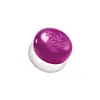What's inside
What's inside
 Key Ingredients
Key Ingredients

No key ingredients
 Benefits
Benefits

 Concerns
Concerns

 Ingredients Side-by-side
Ingredients Side-by-side

Dimethicone
EmollientDimethicone Crosspolymer
Emulsion StabilisingTribehenin
EmollientPolyglyceryl-2 Triisostearate
EmulsifyingSynthetic Fluorphlogopite
Diisostearyl Malate
EmollientTheobroma Cacao Seed Butter
EmollientAgave Tequilana Leaf Extract
AstringentCetyl PEG/PPG-10/1 Dimethicone
EmulsifyingSorbitan Isostearate
EmulsifyingVinyl Dimethicone/Methicone Silsesquioxane Crosspolymer
Polyhydroxystearic Acid
EmulsifyingPolyglyceryl-2 Diisostearate
EmulsifyingDisteardimonium Hectorite
StabilisingEthylhexyl Palmitate
EmollientIsopropyl Myristate
EmollientIsostearic Acid
CleansingLecithin
EmollientPolyglyceryl-3 Polyricinoleate
EmulsifyingTriethyl Citrate
MaskingCaprylyl Glycol
EmollientGlyceryl Caprylate
EmollientButylene Glycol
HumectantWater
Skin ConditioningParfum
MaskingCI 17200
Cosmetic ColorantCI 15985
Cosmetic ColorantCI 77491
Cosmetic ColorantCI 45410
Cosmetic ColorantCI 77891
Cosmetic ColorantCI 15850
Cosmetic ColorantCI 42090
Cosmetic ColorantCI 19140
Cosmetic ColorantDimethicone, Dimethicone Crosspolymer, Tribehenin, Polyglyceryl-2 Triisostearate, Synthetic Fluorphlogopite, Diisostearyl Malate, Theobroma Cacao Seed Butter, Agave Tequilana Leaf Extract, Cetyl PEG/PPG-10/1 Dimethicone, Sorbitan Isostearate, Vinyl Dimethicone/Methicone Silsesquioxane Crosspolymer, Polyhydroxystearic Acid, Polyglyceryl-2 Diisostearate, Disteardimonium Hectorite, Ethylhexyl Palmitate, Isopropyl Myristate, Isostearic Acid, Lecithin, Polyglyceryl-3 Polyricinoleate, Triethyl Citrate, Caprylyl Glycol, Glyceryl Caprylate, Butylene Glycol, Water, Parfum, CI 17200, CI 15985, CI 77491, CI 45410, CI 77891, CI 15850, CI 42090, CI 19140
Dimethicone
EmollientDimethicone/Vinyl Dimethicone Crosspolymer
Skin ConditioningVinyl Dimethicone/Methicone Silsesquioxane Crosspolymer
Water
Skin ConditioningPEG-10 Dimethicone/Vinyl Dimethicone Crosspolymer
StabilisingPolyglyceryl-2 Dioleate
Polyglyceryl-3 Diisostearate
EmulsifyingGlyceryl Behenate
EmollientPEG-10 Dimethicone
Skin ConditioningPolymethylsilsesquioxane
Tea-Dodecylbenzenesulfonate
CleansingVp/Hexadecene Copolymer
Sorbitan Isostearate
EmulsifyingPhenoxyethanol
PreservativeParfum
MaskingTocopheryl Acetate
AntioxidantCaprylyl Glycol
EmollientPEG-10
HumectantEthylhexylglycerin
Skin ConditioningAlbatrellus Confluens Extract
HumectantCamellia Sinensis Leaf Extract
AntimicrobialDimethicone, Dimethicone/Vinyl Dimethicone Crosspolymer, Vinyl Dimethicone/Methicone Silsesquioxane Crosspolymer, Water, PEG-10 Dimethicone/Vinyl Dimethicone Crosspolymer, Polyglyceryl-2 Dioleate, Polyglyceryl-3 Diisostearate, Glyceryl Behenate, PEG-10 Dimethicone, Polymethylsilsesquioxane, Tea-Dodecylbenzenesulfonate, Vp/Hexadecene Copolymer, Sorbitan Isostearate, Phenoxyethanol, Parfum, Tocopheryl Acetate, Caprylyl Glycol, PEG-10, Ethylhexylglycerin, Albatrellus Confluens Extract, Camellia Sinensis Leaf Extract
 Reviews
Reviews

Ingredients Explained
These ingredients are found in both products.
Ingredients higher up in an ingredient list are typically present in a larger amount.
Caprylyl Glycol is a humectant and emollient, meaning it attracts and preserves moisture.
It is a common ingredient in many products, especially those designed to hydrate skin. The primary benefits are retaining moisture, skin softening, and promoting a healthy skin barrier.
Though Caprylyl Glycol is an alcohol derived from fatty acids, it is not the kind that can dry out skin.
This ingredient is also used as a preservative to extend the life of products. It has slight antimicrobial properties.
Learn more about Caprylyl GlycolDimethicone is a type of synthetic silicone created from natural materials such as quartz.
What it does:
Dimethicone comes in different viscosities:
Depending on the viscosity, dimethicone has different properties.
Ingredients lists don't always show which type is used, so we recommend reaching out to the brand if you have questions about the viscosity.
This ingredient is unlikely to cause irritation because it does not get absorbed into skin. However, people with silicone allergies should be careful about using this ingredient.
Note: Dimethicone may contribute to pilling. This is because it is not oil or water soluble, so pilling may occur when layered with products. When mixed with heavy oils in a formula, the outcome is also quite greasy.
Learn more about DimethiconeParfum is a catch-all term for an ingredient or more that is used to give a scent to products.
Also called "fragrance", this ingredient can be a blend of hundreds of chemicals or plant oils. This means every product with "fragrance" or "parfum" in the ingredients list is a different mixture.
For instance, Habanolide is a proprietary trade name for a specific aroma chemical. When used as a fragrance ingredient in cosmetics, most aroma chemicals fall under the broad labeling category of “FRAGRANCE” or “PARFUM” according to EU and US regulations.
The term 'parfum' or 'fragrance' is not regulated in many countries. In many cases, it is up to the brand to define this term.
For instance, many brands choose to label themselves as "fragrance-free" because they are not using synthetic fragrances. However, their products may still contain ingredients such as essential oils that are considered a fragrance by INCI standards.
One example is Calendula flower extract. Calendula is an essential oil that still imparts a scent or 'fragrance'.
Depending on the blend, the ingredients in the mixture can cause allergies and sensitivities on the skin. Some ingredients that are known EU allergens include linalool and citronellol.
Parfum can also be used to mask or cover an unpleasant scent.
The bottom line is: not all fragrances/parfum/ingredients are created equally. If you are worried about fragrances, we recommend taking a closer look at an ingredient. And of course, we always recommend speaking with a professional.
Learn more about ParfumSorbitan Isostearate is an emulsifer and cleaning agent. It is created from isostearic acid and sorbitol.
As an emulsifier, Sorbitan Isostearate prevents oils and water from separating.
Due to its isostearic acid base, it may not be safe for Malassezia or fungal acne.
Learn more about Sorbitan IsostearateThis ingredient is used in makeup and skincare to thicken formulas, reduce shine, and give skin a silky-smooth feel.
It’s a white silicone powder that sits in fine lines and pores to blur their appearance though its effectiveness depends on the particle size.
You'll typically find this ingredient in amounts between 0.1-20%.
Learn more about Vinyl Dimethicone/Methicone Silsesquioxane CrosspolymerWater. It's the most common cosmetic ingredient of all. You'll usually see it at the top of ingredient lists, meaning that it makes up the largest part of the product.
So why is it so popular? Water most often acts as a solvent - this means that it helps dissolve other ingredients into the formulation.
You'll also recognize water as that liquid we all need to stay alive. If you see this, drink a glass of water. Stay hydrated!
Learn more about Water